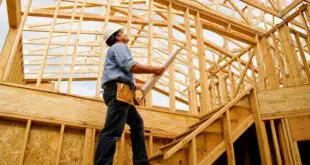For years, metal has been a common roofing material for commercial buildings, barns and storage buildings.
What you may not know, however, is that this roofing material has gone mainstream, becoming a viable option for homes.
Just how much do you know about metal roofs?
Page Contents
Metal Roofs Can Be Installed Over an Existing Roof
If you already have asphalt shingles, you can install a new metal roof over the shingles without needing to remove the old roof first!
Well, of course, you have to check whether your local building code permits doing this in the first place. In some jurisdictions, you might have first fully to tear off the old shingles.
Many municipalities tend to place a limit on the number of layers you can have on the roof of a residential building.
So, we recommend you check with a local contractor such as Austin roofing companies to know how the laws are in your area.
Usually, the number is restricted to two layers, beyond which you would need to completely tear-off at least one of the layers.
Regardless, the lightweight nature of metal roofs means that it can be installed over asphalt shingles without overburdening the house’s structural support.
The fact that you can install a metal roof over an existing roof reduces the cost of installation and the labor required as well.
You might think that replacing an asphalt shingled roof with a metal one would completely ruin the aesthetic of your home, but this is not the case.
Metal roofs are available in a wide variety of styles, sizes, color choices and shapes. So, you can easily find a metal roof that looks very attractive and beautifully blends in with the architectural style of your house.
Metal Roofs Are Very Energy Efficient
Metal is reflective.
Therefore, a metal roof would reflect away a good amount of heat from the sun, preventing it from getting to the interior of your house.
Besides the excellent reflectivity, metal also has a high thermal emissivity.
What this means is that any solar radiant heat that does not get reflected would get absorbed by the metal roof and the heat would get released just as fast.
This way, your metal roof would absorb some of the suns heat during the day and release it at night.
The cooling action of the roof would keep your home significantly cooler if you are in a hot environment. This can reduce your cooling costs by as much as 10-25%.
Furthermore, having a metal roof that’s been coated with a shiny coating would maximize the roof’s reflective capacity, thereby further improving your energy savings.
According to Classic Metal Roofing Systems, having a metal roof could reduce the temperatures in your attic by up to 34%.
The savings you would make in monthly heating and cooling costs could help you recoup some of the money spent on the installation of the metal roof.
Metal Roofs Are Environmentally Friendly
The expected lifespan of a metal roof is between 40-70 years. Meaning, a properly installed metal roof could typically last as long as the house.
At the end of its lifespan, did you know that all metal roofs are 100% recyclable? Metal roofs constitute about 25% of recycled materials.
Steel roofs, for instance, can be recycled repeatedly without resulting in loss of strength.
You will likely never need to replace an aluminum roof. Simply repainting it will do.
Having a minimal carbon footprint is another advantage of a metal roof. Of all metals, Zinc roofs use the least energy in their manufacturing process, meaning there is less damage to the ozone layer.
Metal roofs often provide the ideal platform for homeowners who wish to endeavor in sustainable projects such as installing water panels and rainwater harvesting.
For instance, the non-toxicity of zinc means that rainwater run-off from the roof would not end up contaminating any underground water supply.
Metal Roofs Can Be Dented
Metal roofs are incredibly durable and maintenance-free, and you might think that the roof is indestructible, but it’s not.
One of the main vices to metal roofs is hail. Large golf ball-sized hailstones though, not your average hailstorm.
Metals such as copper and aluminum can dent when large hailstones fall on the roof. Steel is a harder metal, however. So, steel roofs tend to hold up better in regions that experience catastrophic hail.
Besides hail, keep in mind that you might not be able to walk on some metal shingle roofs without damaging them.
Metal panels are UL class rated from 1-4, with Class 1 being the weakest and Class 4 being the strongest and most impact resistant.
Besides heavy hail, you hardly need to worry about your metal roof being unable to withstand extreme weather conditions.
These roofs can competently hold up to heavy winds loads, storms and heavy snow loads as well without the roof getting damaged in any way whatsoever.
Insurance companies look favorably on metal roofs.
This is because the roof is less likely to suffer damage from house fires or extreme weather or so the insurance company would be less likely to have to pay an insurance claim.
Keep in mind though that on the downside, the insurance discount you get could result in an exclusion of cosmetic damage to the metal roof.
It would, therefore, be in your best interest to fully understand the pros and cons of an insurance discount that’s associated with a metal roof.
 A Very Cozy Home Home Decor Tips and Ideas
A Very Cozy Home Home Decor Tips and Ideas 
